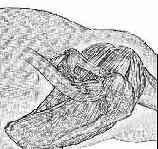
- Discussion:
- deposits lie in the rotator cuff and contain H[2O, CO[3, & PO[4];
- usually does not occur until 4 th decade;
- diabetic patients are more likely to develop asymptomatic rotator cuff calcium deposits;
- > 30% of insulin-dependent diabetics had tendon calcification where as < 10% of nondiabetics have this lesion;
- classification:
- may be divided into acute & chronic phases;
- type I: calcific nodule has sharply defined edges;
- type II: mixture of cloudy and sharp edges;
- type III: cloudy edges and somewhat transparent;
- Indications for Treatment:
- in most cases, clinical symptoms will resolve spontaneously in 7-10 days (where as the deposit may persist on radiographs);
- w/ prolonged symptoms, consider cortisone injection, needling, or arthroscopic calcium excision;
- type II may respond best to puncture aspiration;
- Flouroscopic Aspiration:
- under flouroscopic visualization needle is inserted into the deposit;
- confirmation of needle placement is established, when needle remains in deposit as arm is internally and externally rotated;
- lesion is alternatively injected w/ lidocaine and subsequently aspirated;
- Shoulder Arthroscopy:
- calcified lesion may lie within the tendon which does not allow its visualization in the subacromial space;
- in this case flouroscopy may be used to help identify the lesion (using a needle), and then the arthroscopic shaver can be
used to gently sweep away the overlying bursa which should allow exposure of the lesion
Are the Symptoms of Calcific Tendinitis Due to Neoinnervation and/or Neovascularization?
Arthroscopic treatment of calcific tendinitis of the shoulder.


